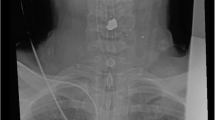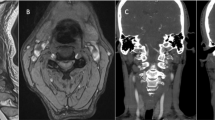Abstract
Introduction
There are no previously reported cases of locked-in syndrome occurring following cervical spinal surgery. We describe a case of locked-in syndrome following an elective cervical foraminotomy and discuss potential etiologies and contributing factors to our patient’s presentation.
Case presentation
A 54-year-old male with a history of head and neck cancer and prior anterior cervical discectomy and fusion presented with neck pain following a motor vehicle accident. The patient underwent C4-C7 left-sided cervical posterior foraminotomy with no intraoperative complications. On postoperative day 1, the patient suddenly developed rapidly progressing weakness of the extremities and soon became non-verbal. CT angiography and near-infrared spectroscopy confirmed a basilar artery occlusion and left vertebral artery dissection. On MRI, infarcts involving the bilateral pons, left cerebral hemisphere, and left cerebellar infarct were identified.
Conclusion
The etiology of locked-in syndrome in our patient remains unclear, but it is likely multifactorial. It is possible that the patient was predisposed to vascular injury from prior radiation therapy to the head and neck. In addition, intraoperative vascular insult may have occurred from vibrational shear stress, in turn leading to a vertebral artery dissection, basilar artery occlusion, and pontine infarct, ultimately resulting in our patient’s locked-in state.
This is a preview of subscription content, access via your institution
Access options
Subscribe to this journal
Receive 1 print issues and online access
We are sorry, but there is no personal subscription option available for your country.
Buy this article
- Purchase on Springer Link
- Instant access to full article PDF
Prices may be subject to local taxes which are calculated during checkout



Similar content being viewed by others
Data availability
No data were generated as part of the current case report.
References
Skovrlj B, Gologorsky Y, Haque R, Fessler RG, Qureshi SA. Complications, outcomes, and need for fusion after minimally invasive posterior cervical foraminotomy and microdiscectomy. Spine J. 2014;14:2405–11.
Yan X, Pang Y, Yan L, Ma Z, Jiang M, Wang W, et al. Perioperative stroke in patients undergoing spinal surgery: a retrospective cohort study. BMC Musculoskelet Disord. 2022;23:652.
Tucker JS. Diagnosis of stupor and coma. Electroencephalogr Clin Neurophysiol. 1969;26:348.
Kenny DJ, Luke DA. ‘Locked‐in’ syndrome. Anaesthesia. 1989;44:483–4.
Breen P, Hannon V. Locked-in syndrome: a catastrophic complication after surgery. Br J Anaesth. 2004;92:286–8.
Smith E, Delargy M. Locked-in syndrome. BMJ. 2005;330:406–9.
Patterson JR, Grabois M. Locked-in syndrome: a review of 139 cases. Stroke. 1986;17:758–64.
Sheth AA, Honeybul S. Vertebral artery dissection following a posterior cervical foraminotomy. J Surg Case Rep. 2017;2017:rjx014.
Jung S, Mono ML, Fischer U, Galimanis A, Findling O, De Marchis GM, et al. Three-month and long-term outcomes and their predictors in acute basilar artery occlusion treated with intra-arterial thrombolysis. Stroke. 2011;42:1946–51.
Micheli S. Cervical artery dissection: emerging risk factors. Open Neurol J. 2010;4:50–5.
Campbell RA, Janko MR, Hacker RI. Hand-arm vibration syndrome: a rarely seen diagnosis. J Vasc Surg Cases Innov Tech. 2017;3:60–2.
White CR, Haidekker MA, Stevens HY, Frangos JA. Extracellular signal-regulated kinase activation and endothelin-1 production in human endothelial cells exposed to vibration. J Physiol. 2004;555:565–72.
Curry BD, Govindaraju SR, Bain JLW, Zhang LL, Yan J-G, Matloub HS, et al. Evidence for frequency-dependent arterial damage in vibrated rat tails. Anat Rec A Discov Mol Cell Evol Biol. 2005;284:511–21.
Krajnak K, Miller GR, Waugh S, Johnson C, Li S, Kashon ML. Characterization of frequency-dependent responses of the vascular system to repetitive vibration. J Occup Environ Med. 2010;52:584–94.
Dutta T, Ryan KA, Thompson O, Lopez H, Fecteau N, Sparks MJ, et al. Marijuana use and the risk of early ischemic stroke: the stroke prevention in young adults study. Stroke. 2021;52:3184–90.
Ducros A, Boukobza M, Porcher R, Sarov M, Valade D, Bousser MG. The clinical and radiological spectrum of reversible cerebral vasoconstriction syndrome. A prospective series of 67 patients. Brain. 2007;130:3091–101.
Masuzawa H, Sato J, Kamitani H, Kamikura T, Aoki N. Pontine gliomas causing locked-in syndrome. Child’s Nervous System. 1993;9:256–9.
Cherington M, Stears J, Hodges J. Locked‐in syndrome caused by a tumor. Neurology. 1976;26:180–180.
Hawkes CH, Bryan-Smyth L. Locked‐in syndrome caused by a tumor. Neurology. 1976;26:1185–1185.
INCI S, ÖZGEN T. Locked-in syndrome due to metastatic pontomedullary tumor-case report-. Neurol Med Chir. 2003;43:497–500.
Ruzevick J, Olivi A, Westra WH. Metastatic squamous cell carcinoma to the brain: an unrecognized pattern of distant spread in patients with HPV-related head and neck cancer. J Neurooncol. 2013;112:449–54.
Xu J, Cao Y. Radiation-induced carotid artery stenosis: a comprehensive review of the literature. Interv Neurol. 2013;2:183–92.
Gujral DM, Chahal N, Senior R, Harrington KJ, Nutting CM. Radiation-induced carotid artery atherosclerosis. Radiother Oncol. 2014;110:31–8.
Leemann B, Schnider A. Unusually favorable recovery from Locked-in-syndrome after basilar artery occlusion. Rev Med Suisse. 2010;6:633–5.
Casanova E, Lazzari RE, Lotta S, Mazzucchi A. Locked-in syndrome: improvement in the prognosis after an early intensive multidisciplinary rehabilitation. Arch Phys Med Rehabil. 2003;84:862–7.
Funding
No funding was received in connection to this study.
Author information
Authors and Affiliations
Contributions
SPW was responsible for writing the report, updating reference lists, organizing figures, revising the report. JS was responsible for writing the report, updating reference lists, organizing figures, revising the report. LB was responsible for revising the report, updating reference lists, assisting with the surgical procedure described. JKC was responsible for revising the report, supervision, gathering patient information, gathering relevant imaging, performing the surgical procedure described.
Corresponding author
Ethics declarations
Competing interests
SPW, JS, LB, and JKC declare that they have no competing interests.
Ethical approval
Informed consent for this case report was obtained from the patient’s immediate family members.
Additional information
Publisher’s note Springer Nature remains neutral with regard to jurisdictional claims in published maps and institutional affiliations.
Rights and permissions
About this article
Cite this article
Wrenn, S.P., Song, J., Billington, L. et al. Locked-in syndrome following elective cervical foraminotomy: a case report. Spinal Cord Ser Cases 10, 32 (2024). https://doi.org/10.1038/s41394-024-00643-4
Received:
Revised:
Accepted:
Published:
DOI: https://doi.org/10.1038/s41394-024-00643-4



